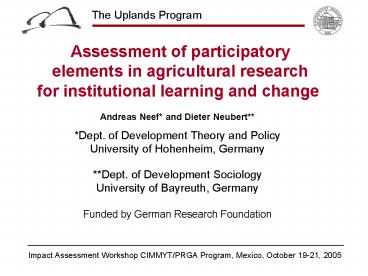Andreas Neef and Dieter Neubert - PowerPoint PPT Presentation
1 / 14
Title:
Andreas Neef and Dieter Neubert
Description:
Objectives and functions of the subproject 'Potential and constraints of ... b) Research epistemology. a) Research methodology. II. Research approach ... – PowerPoint PPT presentation
Number of Views:90
Avg rating:3.0/5.0
Title: Andreas Neef and Dieter Neubert
1
Assessment of participatoryelements in
agricultural researchfor institutional learning
and change
Andreas Neef and Dieter Neubert Dept. of
Development Theory and Policy University of
Hohenheim, Germany Dept. of Development
SociologyUniversity of Bayreuth, Germany Funded
by German Research Foundation
Impact Assessment Workshop CIMMYT/PRGA Program,
Mexico, October 19-21, 2005
2
The Uplands Program
- Collaborative Research Program in the highlands
of Thailand and Vietnam involving 16
subprojects from various disciplines - Participation as a cross-cutting issue
Objectives and functions of the subproject
Potential and constraints of participatory
research approaches
- Provide assistance to other subprojects in
involving local - stakeholders in the research process
(service) - Analyze and assess the potential, constraints
and pitfalls of participatory research
approaches (evaluation) - Document and assess experiences with
institutionalizing participation in research
and extension organizations (context)
3
Conceptual challenges
4
Methodological challenge Comparative assessment
of different subprojects as regardsthe
integration of participatory elements in the
research process
Irrigation technologies
Cover crops
Local knowledge
Farming systems
5
Problem Only linear and prototypical typologies
in the literature
6
Development of an Analytical Framework for
Assessing Participation in Agricultural Research
(AFAPAR) Six dimensions I. Project type II.
Research approach III. Researchers
characteristics IV. Interaction between
researchers and (other) local stakeholders V.
Stakeholders characteristics VI. Stakeholders
benefits
7
Analytical framework for assessing participation
Detailed tables can be downloaded from
www.AFAPAR.net.ms
8
Comparison of subprojects from different
disciplines
Project type
10
8
6
Stakeholders' benefits
Research approach
4
2
Researchers' characteristics
Stakeholders' characteristics
Researcher-stakeholder interaction
Soil science/agroecology
Agronomy/engineering
Economics/social science
9
Differences between external and internal
assessment
Project type
10
8
6
Stakeholders' benefits
Research approach
4
2
Researchers' characteristics
Stakeholders' characteristics
Researcher-stakeholder interaction
Self-assessment by research associate
Self-assessment by project leader
External assessment
10
Changes of participatory elements from Phase I to
Phase II
Adding an applied research component
More flexibility in planning and research
processes
Perceived benefits in terms of innovations and
improved livelihoods
Openness to participation Willingness to learn
from local knowledge
Interest in research topic, positive
experience with previous projects
Long stays in the village Farmers as research
assistants
11
Evolution of participatory elements over
different project phases
50
B1.2/B2.2 Self-assessments D1.2 External
assessment
Phase 1
Phase 2
40
30
Index points
20
10
0
"Agrochemical fluxes"
"Alternate bearing of fruits"
"Water conservation"
12
Subprojects could be categorized into three
groups
Self-assessments by junior researchers
Mango irrigation
Agrochemical fluxes
Conventional research
Micronutrients
Chemical residues in fruits
Soil conservation
Water valuation Mae Rim
Integrated pest management
Conventional researchwith participatory elements
Pests beneficial insects
Resource valuation
Resource tenure
Pectine extraction
Local knowledge
Participatory research
Water conservation
Multi-Agent Systems
0
10
20
30
40
50
60
Index points
whether projects with more participatory
elements are more successful than those with less
is another question!
13
Comparison of subprojects in two different
research programs
Project type
10
8
6
Stakeholders' benefits
Research approach
4
2
Researchers' characteristics
Stakeholders' characteristics
Researcher-stakeholder interaction
Land Use Planning (Culaholo)
Land Tenure (The Uplands Program)
14
- Potential of the analytical framework
- Create a platform for self-reflection and
informed discussions about the rationale of
applying participatory methods in a specific
research context - Provide insights into the relationship between
participatory potential and actual
participation in a research project - Identify the strengths, opportunities and
limits of research projects as regards
participatory approaches - Analyse the evolution of subprojects over time
and support the planning of future research
phases - The analytical framework does not want to
- categorize projects and scientists into
participatory good guys and
non-participatory bad guys. - It certainly can not
- assess the scientific quality and the success
of research projects.

















![Generalizing Transactions ... [... Into a Compositional Means for Building Dependable Systems From Arbitrary Components] Andreas Reuter HPTS, September 26, 2005 PowerPoint PPT Presentation](https://s3.amazonaws.com/images.powershow.com/6990289.th0.jpg?_=201508051111)













